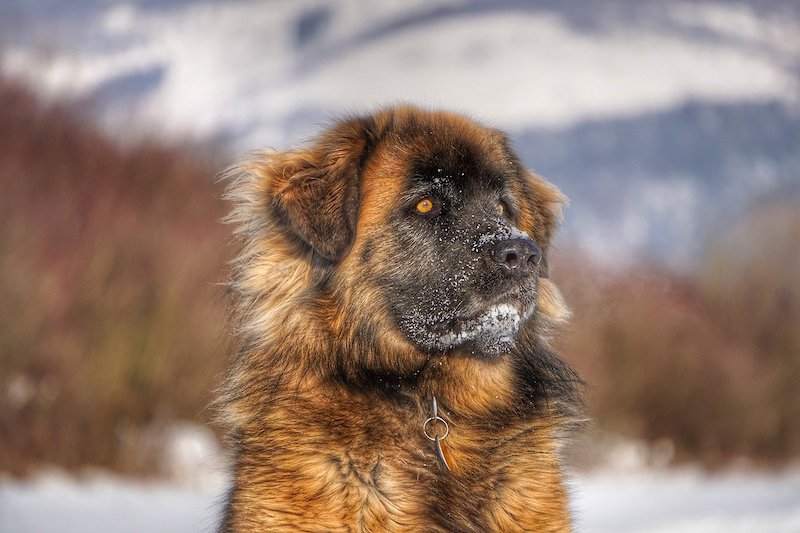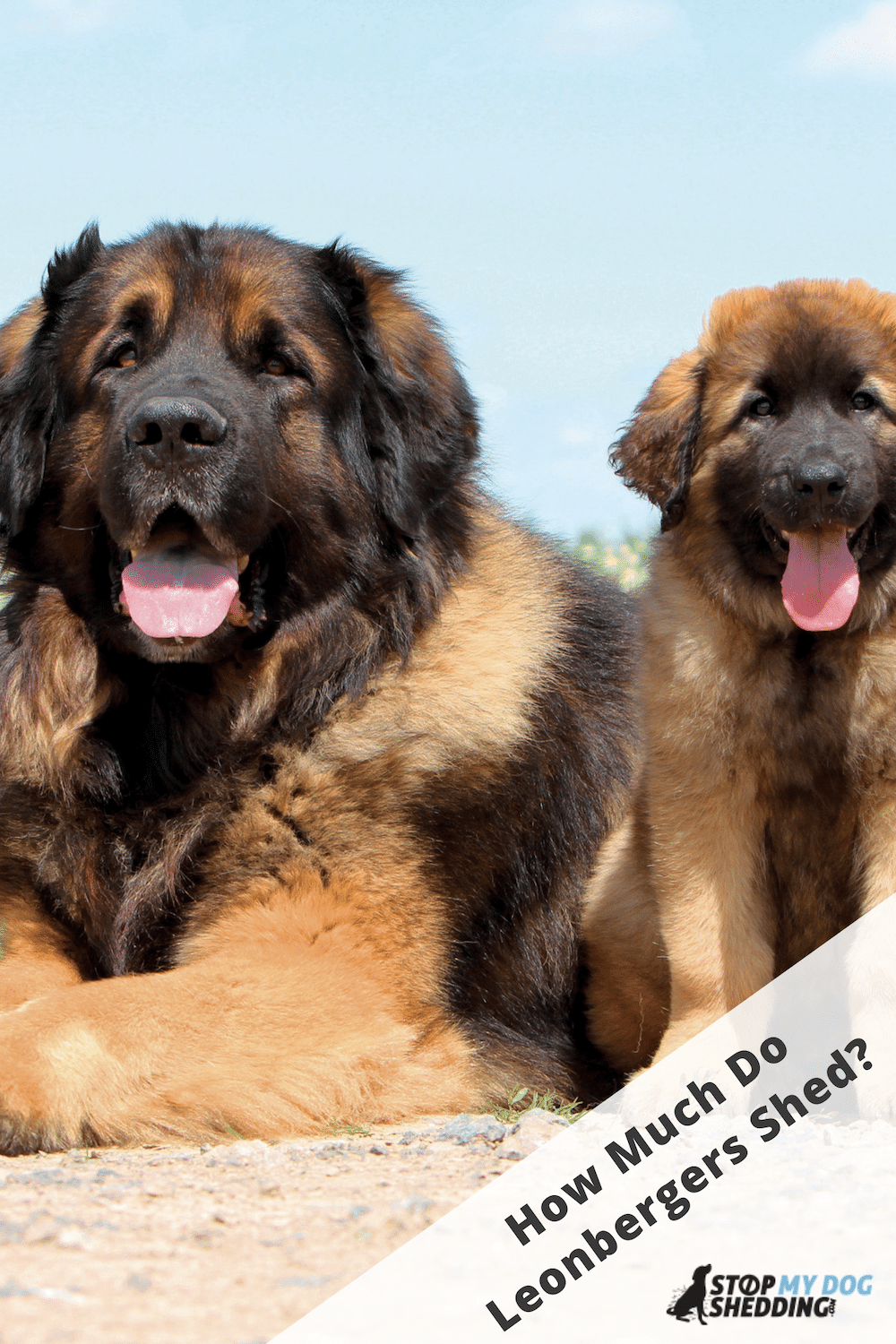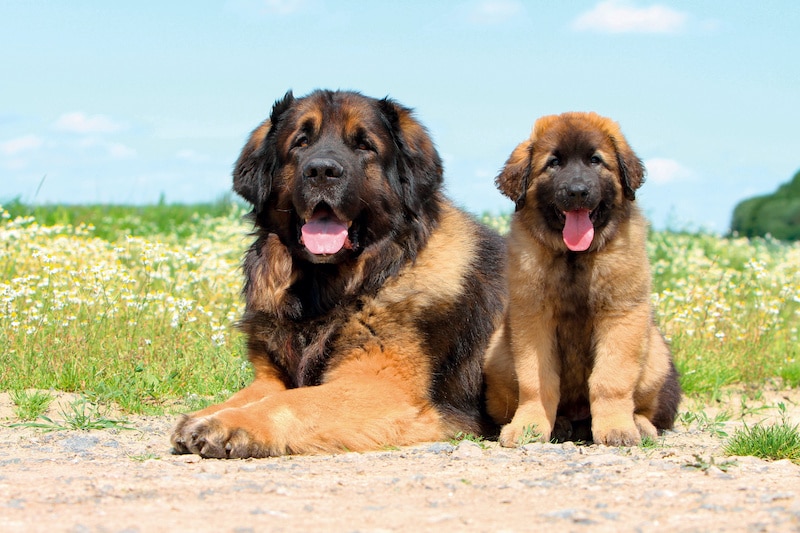Leonbergers (or Leos as they’re commonly known) are a giant working dog that originates from Germany. They were bred for royalty, served the common farmer, and today make faithful family companions.
And yes, they absolutely shed.
Leonbergers are a heavy shedding breed with a thick, water-resistant top coat and a dense, fluffy undercoat. So they shed quite a bit year round, and even more during spring and fall when they blow coat. Brushing your Leo can be very time consuming too, especially if you want to keep the shedding to a minimum.
It’s not all bad news though. Leos are an amazing breed and there are some great ways to reduce shedding, which we’ll be exploring in this article.
Guide to Leonberger Shedding
Leonbergers are a heavy shedding breed. In fact, they are among the heaviest shedding breeds we’ve encountered.
And it’s not hard to see why. They come from the cold climate of Germany and are bred from working dogs like the St. Bernard, Great Pyrenees and Newfoundland. All of which are heavy shedding, double coated breeds.
Specifically though, there are two main reasons why they shed so much fur.
The first reason is because they are just such a large breed. It’s not that big dogs shed more than small dogs, that’s a myth. It’s that there is just more fur that can fall off his coat. So even a moderate shedding large dog will make more of a mess of your home than a small dog.
The second reason has to do with their double coat. Leos have a thick, water-resistant top coat and a dense, fluffy undercoat. Which is basically the perfect recipe for a high shedder.
The main difference between a double coated breed and a single coated breed is that dogs with a double coat typically shed a lot more during seasons like spring and autumn. And this is because their body is naturally preparing them for the upcoming change in season.
For example, they shed their winter coat in spring to prepare them for the warmer temperatures ahead of them, and shed their summer coat in the fall, to prepare for the colder months.
This is perfectly natural, it’s just not so good for people who don’t like a home full of fur. They’re pretty much the exact opposite of a dog like the Italian Greyhound, which we recently wrote about.
Thankfully, you can win the battle though proper grooming!
What Are They Like to Groom?
I’d like to say they’re easy to groom to cut you a break, but that’s just not the case. I mean, they’re not difficult to groom or particularly high maintenance, like the Afghan Hound for example.
But it is going to take you some time and effort to keep his coat in good shape and reduce the amount of fur floating around your home.
The reason they require above average maintenance is simply because of the length and texture of their coat, and the fact that they have a thick undercoat. There’s just so much fur to get through, so you’ll need the right tools for the job.
What’s the best bush to use on a Leo?
For the outer coat, a slicker brush is ideal. This makes light work of matts and knots in his coat, which are common, and will remove the dead hair, dirt and debris from the coat quite easily.
For the undercoat, an undercoat rake, deshedding tool, or simple metal comb works well. It really depends on your budget and preference as to what you choose.
The way to go about brushing is to start with the slicker. Then, once you’ve gone over his coat with to remove the bulk of fur, carefully go over his coat again with the comb, reaching right down to the undercoat, to remove the loose undercoat fur.
Optionally, you can finish up with a bristle brush to improve the shine of his coat, but that’s not needed.
See our shedding brush reviews and buyer’s guide to learn more about the different types of brushes, what they’re used for and how they compare with each other.
Overall, grooming your Leo is not a difficult process, but you should brush once per day and take the time to brush him more thoroughly at least once per week. It’s a commitment, for sure, but will save you hours upon hours of cleaning up after the fact.
Recommended: Go here to see our top-rated dog hair blow dryers
How to Stop Your Leonberger from Shedding Excessively
Your best line of defence against a home full of your Leo’s hair is a regular brushing routine. We’ve already discussed what this involves and what types of brushes you can use.
What we haven’t discussed is why this works so well. Obviously brushing removes the dead fur from the source before it has a chance to reap havoc. But it also helps to improve his coat by spreading the oils of his coat evenly over the skin.
And since dry skin can cause excessive shedding, this can make a big difference over time. It’s also important to avoid doing anything that will dry out the skin and hair, and do more of what promotes a healthy amount of moisture.
For example, avoiding excessive bathing and using human shampoo is one way to protect his coat from drying out. While feeding him a balanced, healthy diet that contains healthy fats (like Omega 3s), and that is made of quality ingredients, can promote hydrated skin and a healthier coat.
Some people even add a small amount of virgin coconut oil or virgin olive oil into his food, as this (in moderation) is a natural, safe and effective way to reduce excessive shedding.
There’s no magic pill solution for shedding, it’s something all dogs do, some more than others. But these tips (and other methods we share here) can make a huge difference and go a long way to significantly reducing the amount of fur that ends up throughout your home.
Recommended: Go here to see our top-rated dog hair blow dryers
Should You Adopt a Leonberger?
Leonbergers make excellent family dogs. Despite their incredible size (up to 31.5 inches tall), weight (up to 170 pounds) and strength, they’re submissive to family members and friendly towards kids.
They have that same gentle giant, quietly confident nature as their relatives, the St. Bernard and Newfoundland. And Leos adopted their courage, loyalty and intelligence too.
Not to mention, they’re great swimmers and can pull heavy objects like the Newfie, which is a valuable skillset to have as a tough working dog, which they are.

They originate from Germany where, according to the AKC, a politician and entrepreneur named Essig was trying to breed a “majestic pet” that would be fit for a king.
And one look at a Leo will tell you he succeeded at this. They are one of the largest, yet most graceful, dignified breeds on earth, sporting a lion-like mane around their chest and neck area to boot.
When it comes to daily life, they don’t bark much, are typically good around other dogs and are happy with a couple hours of exercise each day.
So if you don’t mind a heavy shedding breed, and putting the effort into regular brushing, then you’ll love having a Leonberger as part of your family, as will the whole family.
FAQ
Are Leonbergers Hypoallergenic?
No, Leos are not a hypoallergenic dog breed. In fact, they’re quite the opposite given how heavily they shed. Examples of hypoallergenic breeds include the Basenji and Italian Sighthound.
What Brush Is Best for Leo Shedding?
A slicker brush or pin brush is best to use for the Leos outer coat, while an undercoat rake or metal comb (regular or purpose built deshedding comb) is ideal for his undercoat.
What Are Some Lower Shedding Breeds?
There are lots of breeds that shed less than the Leonberger, so take your pick. However, out of the larger breeds, the Irish Wolfhound, Saluki, or Giant Schnauzer are worth considering. Nothing is going to be the same as a Leo though, they’re one of a kind. So it’s a matter of weighing up the pros and cons.













Please note: By submitting a comment using the above comment form, you confirm that you agree with the storage and handling of your data by this site as detailed in our Privacy Policy.